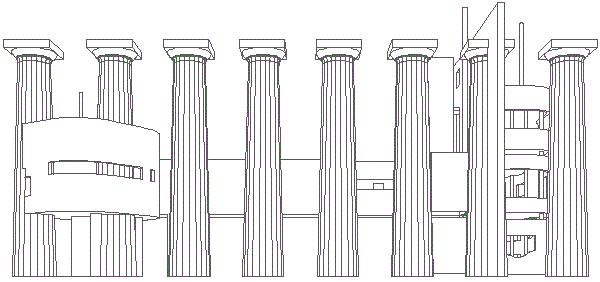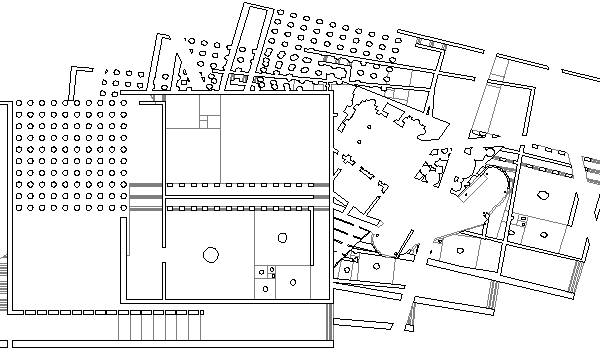2013.11.11 13:27
atemporality at work?
t a m m u z, I did something I've never done before. I printed out your post yesterday, so I could read it more carefully later in the evening, all in the hope of then crafting a proper response. I wound up writing not much of anything, but I continually reread your post, and found more in it with each reading. It was quite stimulating, actually.
I like how our separate participation in the 2008 theory thread now seems to have been more of a spontaneous jazz riff than a tete-a-tete. And I like, too, how atemporality was a key part of the riff. (The continual re-reading of your post last night also turned out to be like listening to jazz.)
Your ATM story ultimately brought to mind the architectural legacy Ludwig II, king of Bavaria--among other things, he actually did reproduce Versailles. Economically, however, Ludwig's projects were not valorization, rather he spent all his family fortune employing artisans, thus investing everything into his kingdom, which he knew would soon come to an end because of Bismarck's looming plan of German unification. Ludwig essentially made sure his money (and there certainly was a lot of it) was spent entirely for the benefit of his kingdom. It was only after he had spent all his money that his own government then abduced him and declared him insane. It seems there may be many interesting parallels between Ludwig's architecture and the Architectural Teller Machine. Interesting too the parallel that Ludwig's Neuschwanstein and Furness's National Bank of the Republic were both completed in the same year.

Eduard Riedel, et al, Schlo▀ Neuschwanstein (Bavaria: 1869-1884).
| |

Frank Furness, National Bank of the Republic [Clearing House] (Philadelphia: 313 Chestnut Street, 1883-84, demolished).
"The city street fašade can provide a type of juxtaposed contradiction that is essentially two-dimensional. Frank Furness' Clearing House, now demolished like many of his best works in Philadelphia, contained an array of violent pressures within a rigid frame. The half-segmental arch, blocked by the submerged tower which, in turn, bisects the fašade into a near duality, and the violent adjacencies of rectangles, squares, lunettes, and diagonals of contrasting sizes, compose a building seemingly held up by the buildings next door: it is an almost insane short story of a castle on a city street. All these relationships of structure and pattern contrast the severe limitations associated with a fašade, a street line, and contiguous row houses."
Robert Venturi, Complexity and Contradiction in Architecture (New York: Museum of Modern Art, 1966), p. 61.
| |
ataxonomic castle jazz
alphabetical, polychromatic, numerical, calligraphic and above all of course pictorial reliant on the history of painting.
Are you familiar with Greenaway's Leonardo's Last Supper (2008) and Nightwatching (2007)? Regarding an article in Art in America (February 2009):
"Finally read the article, and yes it would have been more complete if the notion of reenactment was also addressed, as reenactment involves all the issues: reproduction, cloning, authenticity, degrees of separation, even, to some extent, space-time. I'd say the degrees of separation issue is here the most important in that, like you mention, the reproductions come extremely close to the original, and can even occupy the space of the original, but the reproductions can never be the original. I'm reminded of that aspect of calculus where the curve continues to more and more closely approach + or - 1 but never reaches the actual integer itself. [At least I hope I'm remembering correctly.]
"Bifuracted authenticity" is an interesting notion, but, in terms of authenticity, it's a little misleading--there is still really only one authentic work (the reproduction Marriage of Cana even in original context is still a reproduction). Nonetheless, it brings to mind notions of the Baroque--"Within his double theater Bernini capsulized the beginning of Western culture's new bifurcation of the real and the illusory, introduced mirroring as a henceforth dominant (post) Baroque (stylistic) theme, and, at base (or should I say at the ultimate end), inverted reality into a reenactment of its own illusory mirror (--is this perhaps also the genesis of historiography?)." Plus, the mystical notion of bilocation, or is it actually something scientific as in the space-time continuum? Is the match of the Campo Marzio Axis of Life and the Benjamin Franklin Parkway an example of "bifurcated authenticity"?
So, generally, my take on the article is that 'reenactment' is missing and really should have been included. Greenaway essentially performed two reenactments--one the reenacted natural lighting in situ, and two the reenacted lighting on the reenacted painting at another/nearby site--and Factum Arte reenacted the Marriage of Cana at its original site.
Here a Versailles, There a Versailles, Everywhere a Versailles, sigh--going Baroque in the space-time continuum!"
I have seen Greenaway's ZOO only once (like 11 years ago), and liked all the doubleness. I almost saw it a second time a couple of months ago--I borrowed a DVD from the local free library, but never got around to watching it again. Time for take two, I suppose.
anatomical ataxonomic imaginations
extreme, fertile, conceptional, assimilating, metabolic, osmotic, electro-magnetic, all-frequency
| |
The genesis of Quondam (as a virtual museum of architecture) involved comparative architectural scale. That's not so evident within Quondam's make-up now, but if I go back to Quondam's ur-state, it was the realization that once architecture was mediated digitally via CAD, it became very easy to compare architecture(s) (within the digital realm) at "real size"--very much like having a life size museum of architecture at your finger tips. By 1992 I had a model of Hejduk's Wall House II and a model of a column of the Parthenon--each generated for completely separate reasons. Right now I'm not exactly sure why, but one day in 1993 it dawned on me to merge the two databases to see how the two architectures compared:

The row of columns represents the actual positioning along the Parthenon's pedimental fronts.
Beyond that, Quondam always tries to remain true to (its) virtuality.
virtual 1 : of, relating to, or possessing a power of acting without the agency of matter 2 : notably effective 3 : being functionally or effectively but not formally of its kind
More recently, I'm just beginning to think about mediation in terms of "the function or activity of an intermediate means or instrumentality of transmission." In this case, thinking about the virtual and digital as an "instrumentality of architectural transmission."
2014.02.04
the beginning of Unthinking an Architecture
So, how does all this get to the cutting edge, the place where architectures are unthought? Perhaps the destination is reached when the texts turn into architectures (themselves). All the stories turn into (new) designs. Today's work with the Danteum and the Palace of Ottopia is a prime example of how the 'stories' generate their own 'unthought' architectures.

Now there are glimpses of how Quondam will continue to operate. The whole site is open to unthinking, interpretation, experimentation, but there is a formal place for Unthinking (an) Architecture(s) to unfold and fold again. Or is it to be more labyrinthine? The whole undoing could be connected by links. In any case, proceed by always unthinking whatever is to be figured out, or whatever obstacle might be in the way, or whatever graphics might be best suited for the representation. Does all the unthinking occur within the space-time continuum?
|



